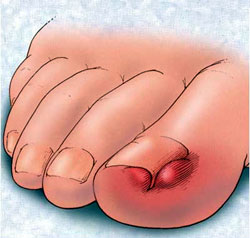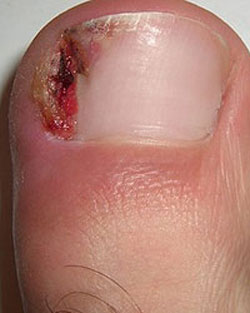 Who would have thought that a simple little nail could limit daily activities? If you suffer from ingrown nails, you already know! Ingrown toenail is a common disease, its treatment is one of the most common outpatient dermatological and surgical operations.
Who would have thought that a simple little nail could limit daily activities? If you suffer from ingrown nails, you already know! Ingrown toenail is a common disease, its treatment is one of the most common outpatient dermatological and surgical operations.
What are the causes of ingrown toenails and how can they be treated?
The essence of the disease is that the edge of the nail grows under the nail bed, “crumpling” it in front of itself, thereby causing pain, which is aggravated by even the slightest pressure. Naturally, inflammation also occurs. Its main symptoms are painful swelling, callus formation, and pus dripping from under the nail. At first, the pain occurs only in certain situations, during irritation, and then becomes permanent when inflammation occurs. This disease most often occurs on the big toes, which is usually caused by wearing tight shoes, local injury, improper pedicure, cutting the toenails to a curve similar to handnails, but it can also be caused by excessive genetic curvature of the nail. The gradually developing inflammatory branch tissue is painfully throbbing, red, and bleeding. The process can often be accompanied by a fungal infection, the treatment of which is also an important task in terms of lasting healing.
 How can ingrown nails be treated?
How can ingrown nails be treated?
Non-surgical treatment – such as trying to raise the nail after soaking the toes, using anti-inflammatory, antibiotic or antiseptic ointments – mostly remains an experiment and rarely brings results in practice.
A definitive solution only for surgical intervention, which is performed on an outpatient basis under local anesthesia.
During the medical consultation, the dermatologist thoroughly examines the problematic nail and its surroundings. He determines which treatment method would be the most effective for the treatment of the ingrown toenail.
What happens during the treatment of an ingrown nail?
 After injection anesthesia of the toe (which is also the most unpleasant part of the procedure), the ingrown nail section, the overgrown, inflamed nail bed and, above all, the dividing layer that ensures the production of the nail, are partially removed. Suture removal 7-10 days after surgery. on the sun. The leg should be kept dry until the stitches are removed. The complete healing time after the treatment of an ingrown nail can take up to several weeks, so a few days of rest are recommended after the operation. It is recommended that the leg that has undergone surgery be shoved and open shoes are worn. Until the end of the wound healing (approx. 3-4 weeks), the use of the sauna, solarium and swimming pool should be avoided!
After injection anesthesia of the toe (which is also the most unpleasant part of the procedure), the ingrown nail section, the overgrown, inflamed nail bed and, above all, the dividing layer that ensures the production of the nail, are partially removed. Suture removal 7-10 days after surgery. on the sun. The leg should be kept dry until the stitches are removed. The complete healing time after the treatment of an ingrown nail can take up to several weeks, so a few days of rest are recommended after the operation. It is recommended that the leg that has undergone surgery be shoved and open shoes are worn. Until the end of the wound healing (approx. 3-4 weeks), the use of the sauna, solarium and swimming pool should be avoided!
Can the surgery have complications?
Rarely, after the operation, minor bleeding or worsening of the inflammatory process may occur, which may require the use of antibiotics. The latter has a higher chance of developing primarily in the case of existing diabetes and blood supply disorders.
Is there a high risk of recurrence?
Treatment of ingrown toenails unfortunately does not bring anywhere near definitive results, the frequency of recurrence can be as high as 16-60%. The disease can be prevented and its return can be prevented by using the correct nail care habits and wearing comfortable footwear.
You can read about the prices of the birthmark examination in the Prices menu item. You can make an appointment for a medical consultation by calling +36 30 5603 983 or by e-mail at info@botoxclinic.hu.

